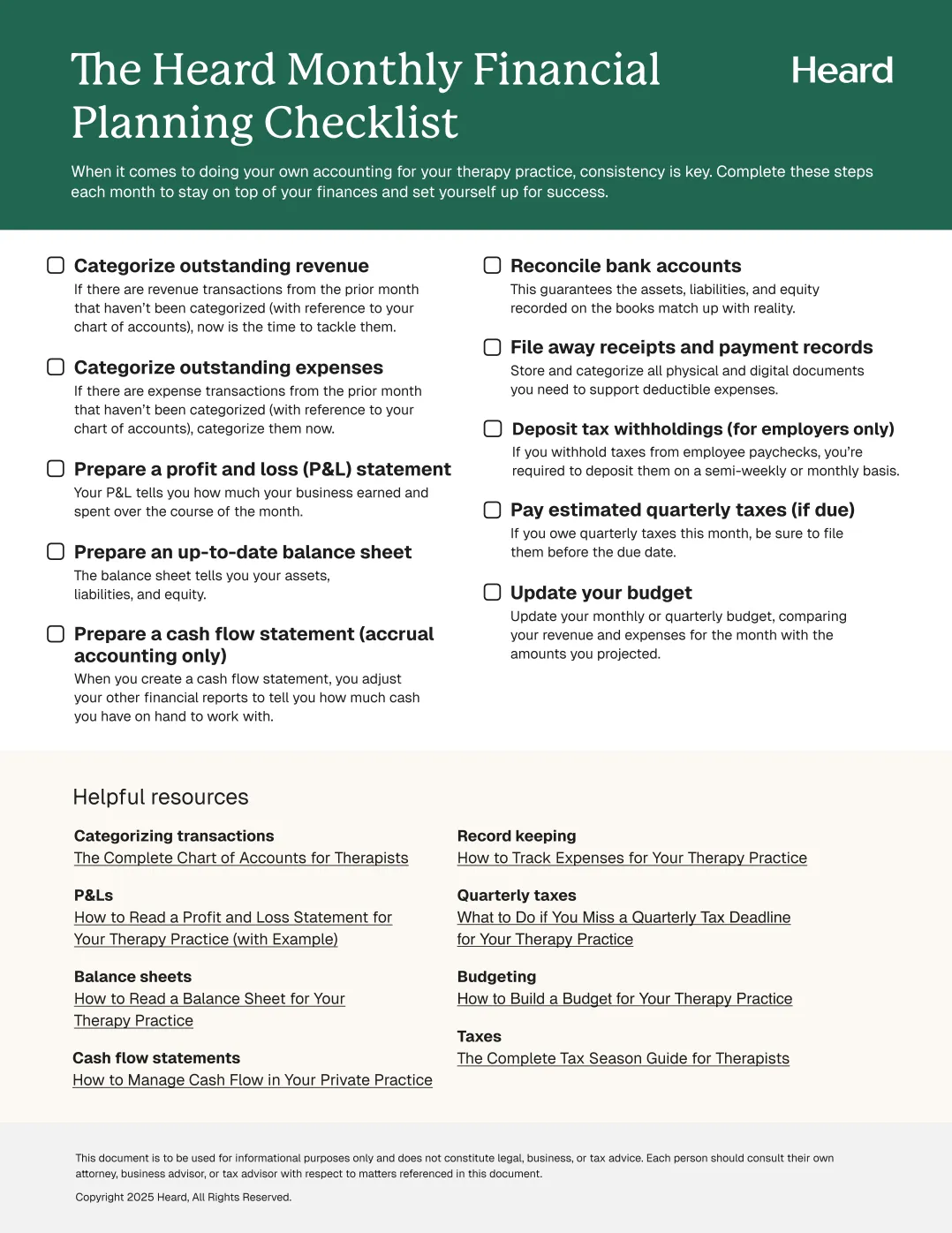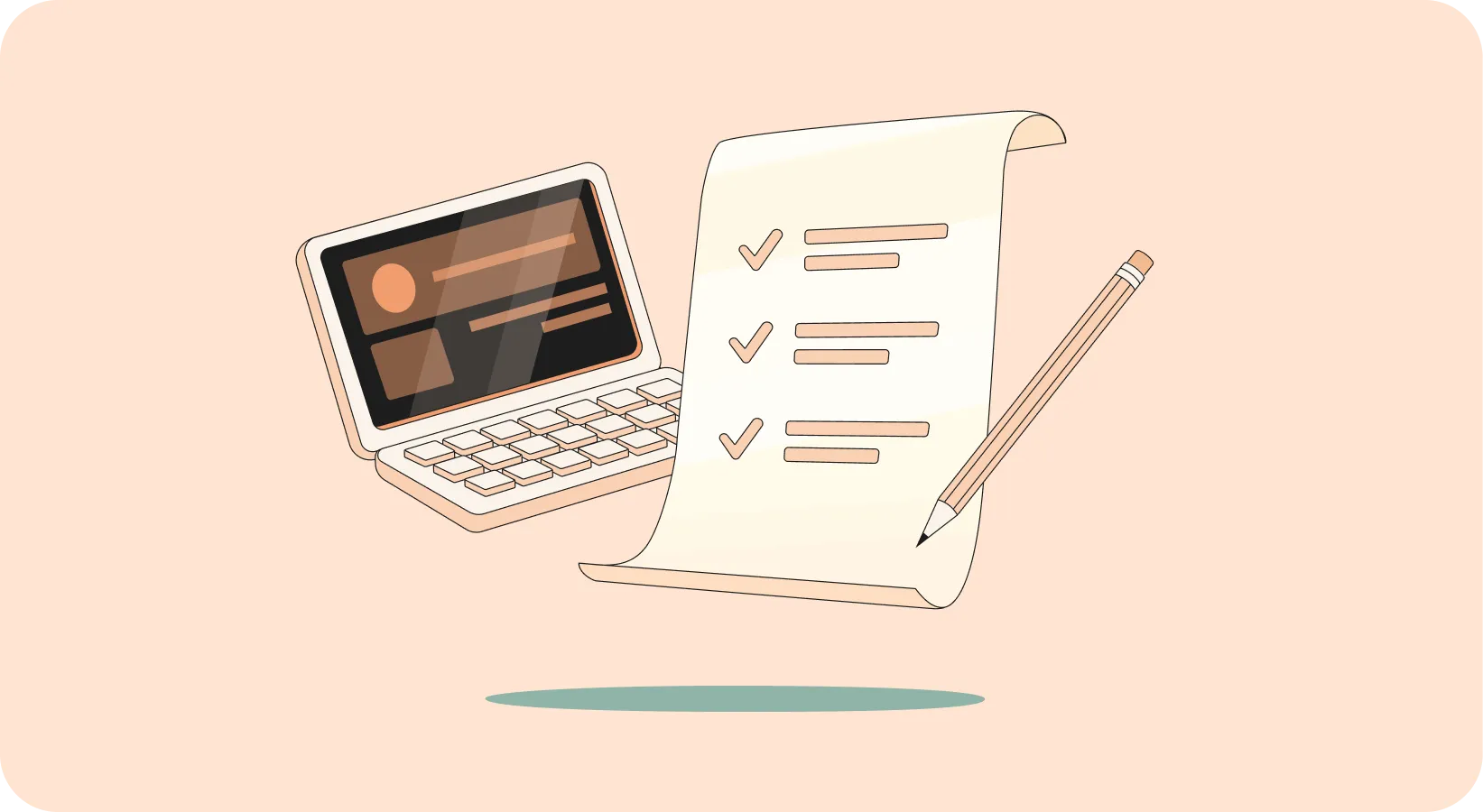As with any business, when you run your own therapy practice, you need to track expenses.
If you don’t, it’s impossible to tell how much profit you’re earning. That means, come tax season, filing an accurate tax return is difficult, if not impossible.
This seven-step guide includes everything you need to know to track your expenses in an accurate, organized fashion. Plus, you’ll learn how to save and organize expense records—like receipts—so you can take advantage of tax deductions.
{{consult}}
Why you need to track expenses for your therapy practice
Two really good reasons to track expenses for your therapy practice:
- So you can see how much you’ve earned, and track how your business is performing
- So you can take advantage of tax deductions
Here’s a breakdown of each.
Unless you track expenses, you can’t see how much you’ve earned over a particular period. Remember:
Revenue - Expenses = Profit
Revenue is often referred to as gross income (income before you take expenses into account) and while profit is referred to net income (income after you’ve taken expenses into account).
You may be able to add up all the money clients have paid you during the month of April, but if you don't know how much money you spent in the same period—on expenses like rent, your phone bill, and software subscriptions—you don’t know how much profit you’ve made.
That makes it hard to plan your business and prepare for the future. And it makes it almost impossible to file an accurate tax return.
The process of keeping track of day-to-day revenue and expenses is called bookkeeping. This is distinct from accounting, which has more to do with filing taxes and making large-scale business plans. Learn about the difference between accountants and bookkeepers.
Tax deductions are the second big reason you need to make sure you track expenses. Many of the expenses you pay to run your therapy practice—from therapeutic toys and tools, to business travel, to membership dues for professional organizations—are tax deductible.
As an example, if you made $120,000 last year, you’ll have to pay income tax on all of that $120,000—unless you report deductible expenses. For instance, if you report deductible expenses totalling $40,000, you’ll only pay taxes on $80,000. That’s a big difference on your tax bill.
Importantly, if you deduct expenses on your tax return, you need to have proof that you incurred that expense. This typically takes the form of receipts.
If the IRS audits your therapy practice, and you don’t have receipts to prove your expenses, you could be on the line for major fines. That’s because, in the eyes of the IRS, if you can’t prove you incurred a deductible expense, then you never really did.
You need to have a way to store your receipts and keep them organized for up to six years after you get them. That’s how far back the IRS can look when they audit you—although, in most cases, they’ll only go back a year or two.
How to track your therapy practice expenses
Follow these seven steps to set up a system for tracking your therapy practice expenses as you incur them, as well as saving and holding on to receipts for your records.
Open a business checking account
If, up until now, you’ve used a personal account for all your therapy practice’s earnings and expenses, book a meeting with your bank to open a business checking account ASAP.
When you use a personal account to pay business expenses, your personal and business expenses become intermingled. Looking at your bank statement, it’s hard to tell which is which.
Granted, you could go back over your account history and carefully determine which debit charges were for your business, and which were for your personal life. But that could significantly eat up time better spent on helping your clients, and eventually, mistakes are bound to happen.
When you have a separate bank account for your therapy practice, and you strictly use it for business expenses and earnings, you never have to worry about figuring out which expenses are personal, and which are business. You can look over your account statement for a particular month and see all your business expenses and earnings.
And if you use accounting software, you may be able to automatically import your expenses as you incur them. More on that below.
Learn which expenses are tax deductible
Not all business expenses can be deducted. And some—like certain business meals—are only 50% deductible.
At the end of the day, you need to track every expense you incur in the course of doing business, so you can see how much profit you’re making. But when you know which expenses are deductible and which ones aren’t, you know exactly the ones for which you need to save receipts.
For the full rundown, see our complete guide to tax deductions for therapists.
Scan your receipts with an app
For many of your regular expenses, you may already get receipts in a digital format. For instance, your landlord may email you a copy of your annual rent receipt. And your internet and phone providers will likely give you online access to receipts from within your account.
Even large, non-recurring expenses, like office furniture and computers, often come with digital receipts.
But everything else—office supplies, business meals, gas for your car during business trips—comes on paper.
Paper is easy to lose and damage. And it’s hard to keep track of, no matter how advanced your receipt filing system.
To save time and energy, and create business records that can’t be destroyed by a spilled coffee or a small gust of wind, digitize all your receipts. Many accounting software packages include phone apps that let you take photos of your receipts and categorize them. If you don’t use accounting software, an app like Expensify can take care of it for you.
Switching to a paperless system is the best way to keep your receipts organized, and ensure you’re able to take advantage of every possible tax deduction for your therapy practice.
Store all your receipts in one place
Once all your receipts are in digital format, you need to keep them stored in a single location.
Your annual rent receipt from your landlord may be sitting in your email inbox. Your phone and internet bills may be accessible only by logging into your respective accounts. And your digitized paper receipts may only exist in the app on your phone.
None of that is sustainable. When it’s time to round up receipts—whether in order to enter them in your accounting software, for the sake of day-to-day bookkeeping, or in order to store them long term—you’ll be doing a lot of running around. And when you have a million different apps and accounts to keep track of, it’s easy to lose track.
Here’s how to get all your digital receipts organized in one place:
- Obtain local copies. Almost all digital receipts stored in online accounts and apps offer the option to download or export PDF copies. If they don’t, you likely have the ability to print to PDF, and save a local copy on your computer. Make retrieving local copies of receipts part of your monthly bookkeeping routine—something you do at the beginning or end of every month. This guarantees you always have copies of receipts on hand for your records.
- Upload them to the cloud. Set up an account with Google Drive or Dropbox, with a directory designated “Receipts.” Every month, as part of your bookkeeping routine, upload all your local copies of receipts to this folder. Storing your receipts in the cloud not only insures you against computer meltdowns or thefts. It makes them easy to share when you work with a bookkeeper or accountant.
- Back up the cloud. Even the cloud isn’t impervious to outages. When you upload your receipts to the cloud, either back up extra copies onto a USB key, flash card, or external hard drive, or after uploading local files, download the contents of your “Receipts” folder as a zip file, and then back it up on physical media.
Sorting through files may seem onerous at first, especially if you have lots of catch-up bookkeeping to do. But, make it part of your monthly routine, and it will soon become second nature.
And remember: six years. That’s how long you should store your receipts for deductible expenses in case of an IRS audit.
{{consult}}
Connect with your bookkeeping system
Whether you’re an Excel maven who does their own bookkeeping with spreadsheets, or you use accounting software, or you even work with a professional bookkeeper and/or accountant, you need to link up your expenses with whatever bookkeeping system you use.
The goal is to get as close as possible to a scenario where, every time your business incurs an expense, it’s immediately recorded on the books.
- If you use spreadsheets to do your own bookkeeping, importing expenses may take the form of entering them whenever you incur them. Or, if you don’t have a large volume of expenses, it may mean reviewing your online bank statement every week, and entering your expenses based on that.
- If you use accounting software for your therapy practice, you should be able to set it up to automatically import all expenses from your bank account to your general ledger. It’s still up to you to make sure those expenses are accurately categorized, however.
- If you work with a bookkeeper, they can automatically import your expenses from your bank account and categorize them for you. Alternatively, you can send them copies of your receipt, and they can make bookkeeping entries based on those.
Whatever bookkeeping method you use, the most important part of this step is setting up a routine whereby your expenses always get recorded on the books. For DIY bookkeeping, that means setting a regular schedule to do the work manually.
If you have a bookkeeper, it may mean answering the occasional question about how an expense should be categorized—but otherwise, your system is hands-free.
Conduct regular expense reviews
Once you’ve connected your expenses to your bookkeeping system, and you have a routine in place for recording all your receipts and storing them in one place, you have everything you need to determine your profit and take advantage of tax deductions.
Now is a good time to set up a recurring expense review. Doing an expense review means looking over your expenses for a particular period, and finding ways to lower or even completely cut them.
This is when it’s especially helpful to work with an accountant who can sit down and go over your expenses with you. Reviewing your expenses on at least a yearly basis, when you file your taxes, is simply good housekeeping.
It helps you find ways to save money by either completely cutting expenses, or finding new ways to lower them. That could be something as basic as canceling a subscription to an app or service your practice never really uses, to finding a new office space (or even going fully remote.)
Consult with a professional
If you find you often make errors when tracking your expenses, or you often forget to record expenses on the books, don’t feel bad.
After all, you started a therapy practice so you could help clients—not so you could spend hours every month trying to catch up on bookkeeping.
One way to ensure you track and categorize your expenses accurately, and your books are up to date, is to work with a professional bookkeeper. Even better is to work with a bookkeeper and an accountant, which guarantees you’ll be able to take advantage of as many tax deductions as possible.
Learn more from our article on bookkeepers vs. accountants.
—
Always scrambling to keep up with the bills? Careful budgeting can help you plan for business expenses. Learn how to create a budget for your therapy practice.
This post is to be used for informational purposes only and does not constitute legal, business, or tax advice. Each person should consult their own attorney, business advisor, or tax advisor with respect to matters referenced in this post.
Bryce Warnes is a West Coast writer specializing in small business finances.
{{resource}}
Manage your bookkeeping, taxes, and payroll—all in one place.

Discover more. Get our newsletter.
Get free articles, guides, and tools developed by our experts to help you understand and manage your private practice finances.
Heard keeps track of how much your business is making and spending, broken out by category. Book a free consult to learn more.
Schedule a free consult




